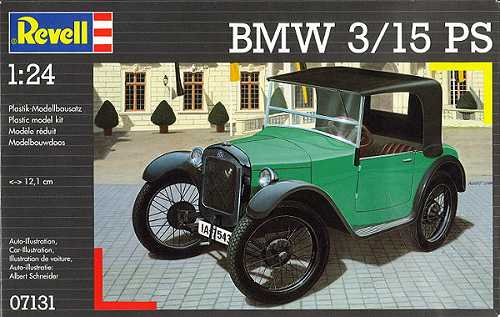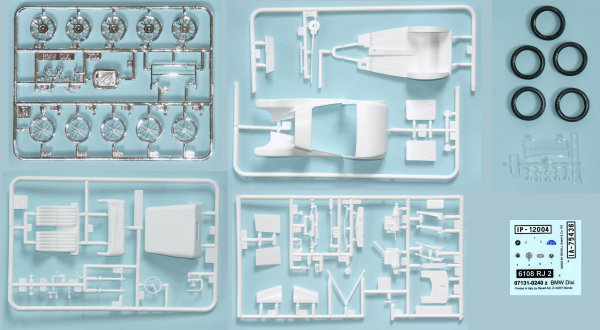
|
KIT: |
Revell 1/24 BMW 3/15 PS |
|
KIT # |
07131 |
|
PRICE: |
€ 12.50 |
|
DECALS: |
Three cars (license plates) |
|
REVIEWER: |
Martin Sczepan |
|
NOTES: |

|
HISTORY |
The first BMW
Today BMW is one of the big German car manufacturers known for its rather expensive and luxurious cars but 75 years ago the beginnings of the company as a car manufacturer were rather humble...
Everything goes back to 1896 when the Heinrich Erhard founded the „Fahrzeugfabrik Eisenach” in Eisenach, Thuringia. His original plan was to manufacture arms for the imperial German army but he soon realized that building cars was promising field of business. So he bought the license to build the French Decauville car and sold it under the name ‘Wartburg’ (The Wartburg is a medieval castle above the city of Eisenach and probably the historically most significant building in Germany). In 1903 Erhard left the company and it was renamed DIXI-Werke. Legend has it that during a meeting to find a new name for the cars one of the participants closed his words with the latin phrase ‘dixi’ (I have spoken). By the way: The other latin named German car company - Audi (‘listen!’) was also founded around that time...
Under the technical direction of Willy Seck the company earned a reputation for its reliable cars although production numbers of most car models were rather small. Also war and economical crisis left their marks and after World War One the company was bought by the ‘Gothaer Waggonfabrik’ (of the Gotha bomber fame).
Economically the 1920ies were a very turbulent time in Germany. Phases of rapid economically growth were followed by phases of recession and hyper inflation. Nevertheless also in Germany the market for cheap small cars was growing. The number of registered cars was doubling between 1926 and 1929. So the DIXI company decided to build a small car to get their share of that fast growing market. Instead of developing a new car it was decided to license build the Austin seven. The Austin can be regarded as something like the ‘European Model T’. Small, cheap and reliable it brought motorization to a new level. But in difference to its American sibling it was through licensing that it spread over Europe. In Germany it was built as DIXI, in France as Rosengart, in the USA as Bantam and even in Japan it was manufactured under the name Datsun... In 1928 the DIXI company started the production of the car as DIXI 3/15 PS. Only minor changes to the original design – including left hand steering and change to metric system – were made. But it was already to late and the company collapsed...
After the end of World War One the situation for BMW - which was founded as an aero engine manufacturer became difficult. The Versailles treaty strongly restricted airplane manufacture in Germany and companies had to look for other fields of business. So BMW turned to truck and boat engine, motorcycle and later car manufacture. When DIXI collapsed, BMW took the opportunity and bought the license for the Austin seven as well as the Eisenach factory. For the first months the production of the car continued as BMW 3/15 PS DA1. The designation was derived from the taxation class (3), engine power (15 hp with PS being the German equivalent of hp) and DA stands for “Deutsche Ausführung” (German version). But BMW wanted to build the car with a more modern body in steel construction instead of the aluminum body of the original Austin/DIXI. So in April 1929 production of the modernized 3/15 PS DA2 with steel body - strongly influenced by the French Rosengart version of car - started. Engine, transmission and suspension remained unchanged. The car was built in different body configurations 2 and 4 seat convertible, sedan, coupe, tourer and some more. After some suspension modifications the cars were designated as DA3 and DA4. Production lasted until 1932 when the license agreement with Austin expired. It was replaced with the 3/20 and in 1933 the 303 model on the Eisenach production line. All in all about 25000 DIXI/BMW 3/15 PS were built.
Epilogue
The end of the 3/15 was not the end of the BMW-Austin connection. When BMW bought the British car company Rover in the mid 1990ies they also inherited the last successful Austin design. A car which initially was also designated as Austin seven but became famous as the ‘Mini’.
Some technical details:
Engine: 4 cylinder water cooled four-stroke, 750 ccm, 15 hp
Weight: about 400 kg
Top speed: 75 km/h (45 miles/h)
Acceleration 8 to 40 km/h (5 to 25 miles/h): 10 seconds
Fuel consumption: 5-6 liter/100 km (mileage about 45 miles/gallon)
|
THE KIT |

The kit represents a BMW DIXI 3/15 PS DA1 model in two-seat convertible configuration as it was built from 1928 to April 1929. The small side opening box contains five sprues - three in white, one transparent and one chrome plated sprue, five vinyl tires, a small decal sheet and a typical Revell instruction sheet. All parts are packaged in one plastic bag with the exception of the chrome parts which are bagged separately. The almost eighty parts are crisply detailed but the molding quality is not as good as with other modern Revell kits. There is only a small amount of flash but a plethora of ejector pin marks - some in quite visibly spots like the door insides. Also sink marks are abundant - most noticeably on the driver’s cabin floor and some transmission parts.
The layout of the kit could be described as semi-curbside - frame and base plate are molded as one part but engine, transmission and suspension come as separate and nicely detailed parts. As often with car kits the use of chrome plating is somewhat overdone. Chrome plated parts include: spoked wheels, radiator housing, wind shield frame and headlights. Most picture of DIXIs I have seen show only the headlight rings in chrome (or more likely nickel) plating, sometimes the windshield frame. But I still have to come across a picture of a DA1 model with chrome plated radiator housing. With the later DA2 to DA4 models this was not so unusual. But since these cars were ‘economy’ cars and extensive chrome plating was considered to be luxury at the time, glossy black is much more likely than shiny chrome for these parts (as also the box art suggests).
The engine compartment is nicely detailed with only some additional wiring required to make it stand out. To show the engine, the hood can be displayed open although the parts are somewhat thick and should be replaced by scratch built parts in this case. Other options include open or closed doors and open or closed convertible top. The clear sprue contains headlight and taillight lenses and windows. The windows are somewhat thick but since these are totally plane it should be no problem to replace them with clear styrene sheet. Construction sequence is broken down into 24 steps with color information given for Revell paints. The decal sheet contains three different front license plates, dashboard instruments and DIXI and BMW company signs for the radiator. Only one paint scheme is given by Revell - emerald green, but other color combinations are possible - although I didn’t find any information on factory colors. Two details are strangely missing in the kit one is the radiator cap decorations - which should be a centaur figurine for a DIXI and a small circular BMW sign for the BMW and - more important - an exhaust system...
|
CONCLUSIONS |
This is a nice little model of a historically significant car. It will probably be an easy and pleasant build resulting in an attractive little model. Some filling and sanding will be required for the sink and ejector pin marks. And with the detailed engine compartment and suspension parts the kit will form a good base for diorama and conversion projects.
Highly recommended.
|
REFERENCES |
A nice web site about the car (German language): http://www.dixi-automobile.de
Review sample courtesy of me and my wallet.
If you would like your product reviewed fairly and quickly by a site that has nearly 250,000 visitors a month, please contact me or see other details in the Note to Contributors.